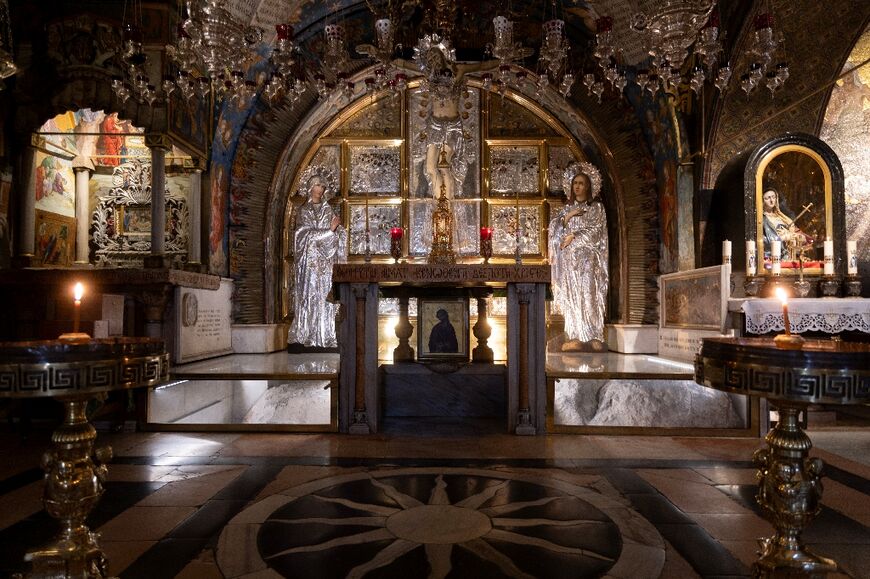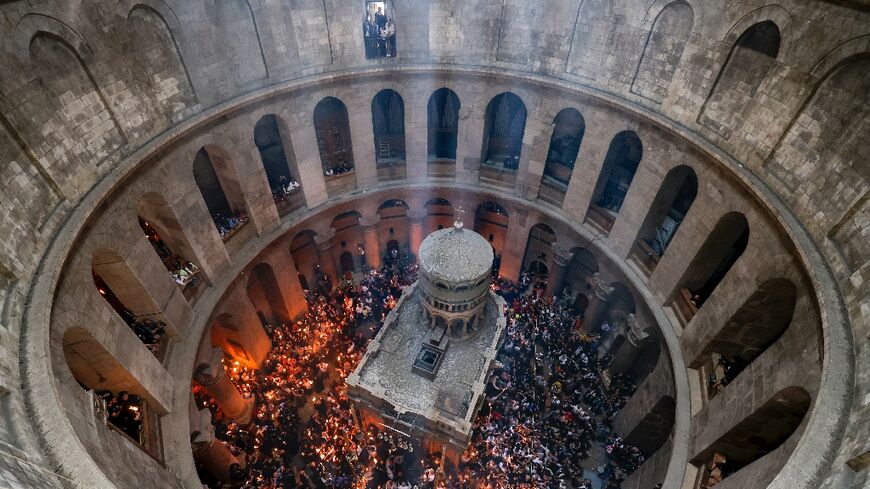Jerusalem Christian landmark emptied of pilgrims

Devoid of visitors, the Church of the Holy Sepulchre in Jerusalem's Old City is haunted by an unusual quiet.
The holiest place in Christianity has been emptied of its normal throngs of visitors by the war between Israel and the Islamist Hamas movement in the Gaza Strip.
Briton Noel Gomez, a Catholic, organises Christian pilgrimages and stood where the faithful say Jesus Christ was crucified, interred and resurrected.
It was practically empty.
"I'm shocked to see this," he told AFP. "I thought maybe at least 50 or 100 people here. It's only me and you here now."
At the beginning of November he was supposed to accompany a 60-strong group to the church. But since the October 7 attacks on Israel such tours have been cancelled.
Under normal circumstances, there would be snaking queues of people wanting to visit the final Stages of the Cross in the church in annexed east Jerusalem.
It usually takes "one and a half to two hours in the queue" for the final station, the marble Edicule, the presumed tomb of Christ, said Gomez, 50.
The October 7 Hamas attacks on Israel killed 1,200 people, mostly civilians, the Israeli authorities say. It was unprecedented in violence and scale.
In response, Israel vowed to eradicate Hamas and has relentlessly bombarded Gaza ever since, killing more than 14,000 people, also mostly civilians, according to the Hamas government.
- 'It's empty' -
"It's like the feeling of Covid again. Very sad," said Israeli tour guide Naomi Miller, visiting the site by herself.
"One of the holiest sites in the world to Christians. And it's empty."
Coptic priest Kyrillos Alorshalemy, 41, said he appreciated the quiet so he could pray and meditate.
In normal times, he said he would have to stand for hours because people "ask priests to pray for them -- 10, 20 people every day".
The lack of crowds means "it is easier to park and get pictures", said a 43-year-old smiling woman who asked not to be identified.
She prays on behalf of paying customers unable to do so in person.
Their prayers were printed out, and she photographed them before the Stone of Unction, the rock slab where tradition says the body of Jesus was prepared for burial.
Franciscan Sister Maria Celina Mendoza said she had mixed feelings. She arrived in September for a three-month stay, but spent almost a month "locked up" in a pilgrims' house in the Holy City after October 7.
Returning at the beginning of November, she felt "great emotion at being able to enter alone" the tiny sanctuary, with "no one telling you to leave".
- 'Really sad' -
The 69-year-old Mexican nun, a missionary in Angola, added: "On the other hand, the fact that all these people... have left makes me really sad."
With no pilgrims or tourists, residents now have "easy access, let's say, that we don't have all the time", said a Palestinian Greek Orthodox woman, 39, who preferred not to give her name.
But "the reason behind it is so sad", she said.
"This is the first time that I'm able to come back, to get the chance to pray and maybe light a candle and pray for peace."
Much of the current activity around the holy building is linked to restoration work begun at the start of last year.
Franciscan Father Stephane Milovitch, director of the Cultural Heritage Office for the Custodia Terrae Sanctae in Jerusalem, said work to restore the basilica's pavement, and some archaeological excavation, has "begun again" with the return of some Palestinian workers.
The 57-year-old Frenchman said he had also noted the return of some "Filipino, Indian and some South American" immigrants.
"The Church of the Holy Sepulchre reunites Christians separated elsewhere" as it is administered by the Roman Catholic, Greek Orthodox and Armenian Orthodox communities, and frequented by the Coptic and Syrian Orthodox churches, he said.
And with no crowding, the current "catastrophe" at least offers "time to meditate and bear in our prayers the suffering of one and all".







